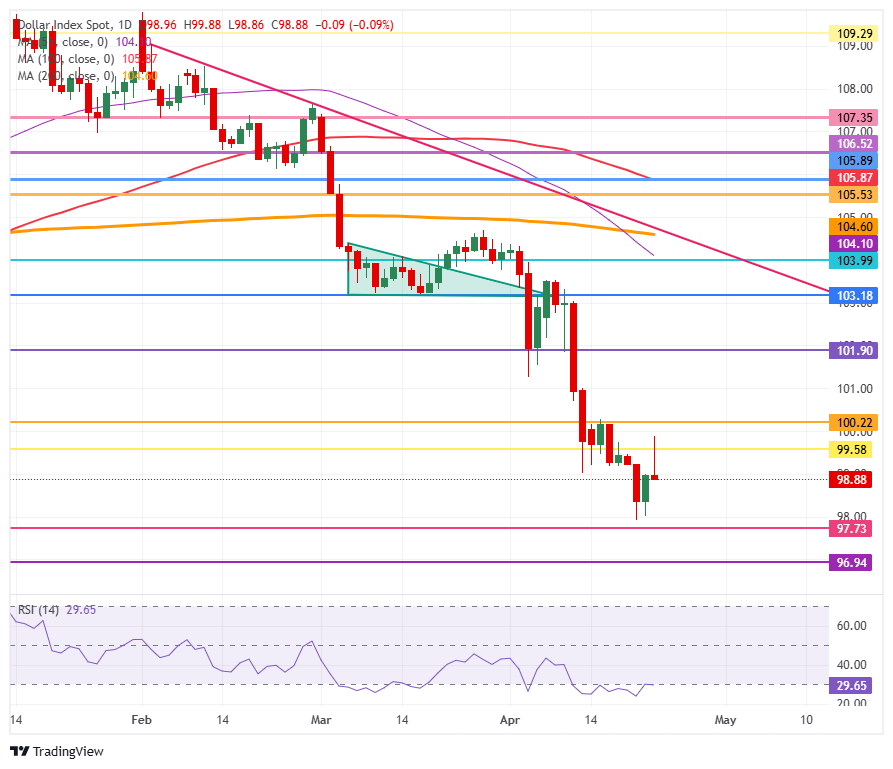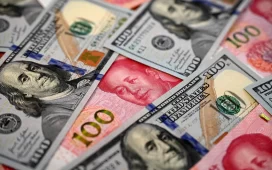- The US Dollar gives up earlier gains and trades flat at 99.00 in the US Dollar Index.
- Bonds and equities popped after President Trump rebuked earlier stances on China and the Fed.
- The US Dollar Index remains capped below the 100.00 round level and could dip again in a technical rejection trade.
The US Dollar Index (DXY), which tracks the performance of the US Dollar (USD) against six major currencies, trades broadly flat near 99.00 at the time of writing on Wednesday after a pop in early Asian trading towards the 100.00 big figure. The pop in the DXY came on the back of comments from United States (US) President Donald Trump late Tuesday, saying that he had no intention of firing Federal Reserve (Fed) Chair Jerome Powell, despite being frustrated with the high interest rates. The President also said he would be ‘nice’ to China if they come to the negotiating table, offering an olive branch by promising tariffs on China would be much lower than they are now, Bloomberg reports.
On the economic calendar front, all eyes are on the S&P Global preliminary Purchasing Managers’ Index (PMI) numbers for April. Traders already got a flavor with the European PMI data compiled by S&P Global and Hamburg Commercial Bank (HCOB) released earlier in the day. The mean theme in European core countries is that Services in Germany, France and the Eurozone as a whole fell into contraction and missed expectations across the board.
Daily digest market movers: US PMI vs European PMI
- At 13:45 GMT, the S&P Global PMI preliminary data for April is due:
-
- Services PMI is expected to decline to 52.8, from the previous 54.4.
- Manufacturing PMI is expected to contract to 49.4, coming from 50.2.
- Three Fed speakers are lined up for this Wednesday:
-
- At 13:00 GMT, Federal Reserve Bank of Chicago President and CEO Austan Goolsbee delivers opening remarks in a virtual presentation at the Federal Reserve Bank of Philadelphia Economic Mobility Summit.
- Near 13:30 GMT, St. Louis Fed President Alberto Musalem delivers remarks at the Fed Listens Event along with Fed Governor Christopher Waller.
- Equities are rallying across the board on the back of the softening stance from US President Trump on China and the Fed. US futures pre-market are up over 2%. The German Dax is outperforming by 3%.
- The CME FedWatch tool shows the chance of an interest rate cut by the Federal Reserve in May’s meeting stands at 4.8% against no changes at 95.2%. The June meeting still has around a 65.4% chance of a rate cut.
- The US 10-year yields trade around 4.29% as US bonds are bid together with equities, which means yields are softening.
US Dollar Index Technical Analysis: Has Trump lost credibility?
The US Dollar Index (DXY) attempted to regain control at the 100.00 level, though it failed. The whole DXY gains during Asian hours this Wednesday have already been pared back. Although President Trump might have opened the door for negotiations, extended an olive branch to China, markets are clearly seeing it as a sign of weakness from the Trump administration, as they lost control over the stock market with the rout on Monday, having forced the President’s hand to ease off on his harsh stances.
On the upside, the first resistance comes in at 99.58, which has triggered a firm rejection and remains the first level to look at. Should US Dollar bulls resurface, look for 100.22 with a break back above the 100.00 round level as a bullish signal of their return. A firm recovery would be a return to 101.90.
On the other hand, the 97.73 support is very close and could snap at any moment. Further below, a rather thin technical support comes in at 96.94, before looking at the lower levels of this new price range. These would be at 95.25 and 94.56, meaning fresh lows not seen since 2022.

US Dollar Index: Daily Chart
US-China Trade War FAQs
Generally speaking, a trade war is an economic conflict between two or more countries due to extreme protectionism on one end. It implies the creation of trade barriers, such as tariffs, which result in counter-barriers, escalating import costs, and hence the cost of living.
An economic conflict between the United States (US) and China began early in 2018, when President Donald Trump set trade barriers on China, claiming unfair commercial practices and intellectual property theft from the Asian giant. China took retaliatory action, imposing tariffs on multiple US goods, such as automobiles and soybeans. Tensions escalated until the two countries signed the US-China Phase One trade deal in January 2020. The agreement required structural reforms and other changes to China’s economic and trade regime and pretended to restore stability and trust between the two nations. However, the Coronavirus pandemic took the focus out of the conflict. Yet, it is worth mentioning that President Joe Biden, who took office after Trump, kept tariffs in place and even added some additional levies.
The return of Donald Trump to the White House as the 47th US President has sparked a fresh wave of tensions between the two countries. During the 2024 election campaign, Trump pledged to impose 60% tariffs on China once he returned to office, which he did on January 20, 2025. With Trump back, the US-China trade war is meant to resume where it was left, with tit-for-tat policies affecting the global economic landscape amid disruptions in global supply chains, resulting in a reduction in spending, particularly investment, and directly feeding into the Consumer Price Index inflation.





